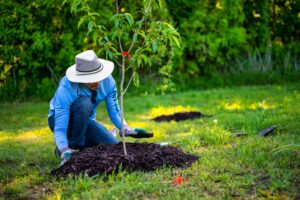
Rooted in Beauty – A Comprehensive Tree Planting Guide for Ann Arbor
Trees do so much for us: they provide homes for wildlife, food sources for our crops and clean water and air for our communities. But how do we make sure they are planted properly?
After planting, thoroughly water your newly planted tree. This helps eliminate air pockets around the roots and ensures that soil is firmly packed.
Choose the Right Tree
ANN ARBOR, MI — Whether shading a patio or enhancing the curb appeal of your home, trees are an important part of our landscape. They add value and beauty, and even improve air quality by reducing soil erosion.
A tree removal service specialist can help you choose a good fit for your home. They can discuss desired uses for the tree, such as providing privacy screening or adding color to the fall and spring landscape.
They will also recommend a tree that is suited for your climate and soil type. Soil chemistry can vary widely between different areas, and the right amendments can make all the difference to your new tree’s success.
It’s a good idea to take a soil test at the site where you plan to plant. This can reveal important information such as pH level and nutrient content, which can influence the health of your newly planted tree. The optimum time to plant a tree is in late March through early June or October through mid-December.
Preparing the Soil
Trees grow best in a location that allows the roots to spread out naturally. In urban settings, construction often compacts soil, preventing root penetration and depriving trees of essential oxygen.
When planting a new tree, consider the ultimate size of its canopy as well as how it will fit in your yard and with other landscape elements such as sidewalks or driveways. It is also important to know where your utility lines are and to contact your local utilities before digging. Accidentally hitting a line can be dangerous and costly.
After planting, water your trees thoroughly. Make sure the soil is saturated, but not muddy. This helps to eliminate air pockets, and it is especially helpful for newly planted bare-root stock. After the initial watering, mulch around your trees 3-6 inches deep with a material such as wood chips or pine needles. This will retain soil moisture and control weeds and grass. Be sure to remove the mulch in warm weather to prevent sun-scald of young evergreen trees.
Digging the Hole
Whether you’re planting a single tree in your own yard or a group of trees in a reforestation project, getting the hole right is vital. A properly dug hole provides a solid foundation for the roots and ensures the success of your new tree.
Dig a saucer-shaped hole that is at least as wide as the root ball and about the same depth. Then rototill the area to loosen and prepare the soil for planting.
A firm bottom and firm sides in the hole help reduce reliance on staking, which can harm the roots, and provide a healthy and stable environment for your tree.
Before digging, call 811. This free service locates all gas, water, and electric lines before you dig, protecting you from costly damage and ensuring that your new tree gets the power it needs to grow.
Planting the Tree
Tree planting is more than just a fun community activity, it improves local climate resilience by reducing the impact of heatwaves and floods. It also provides bees, birds and other wildlife habitat.
Planting a tree requires thorough planning, careful selection and planting, and proper maintenance. Poorly planted or maintained trees and shrubs may delay their growth, suffer from insect or disease damage, or die.
The best time of year for most species is spring and fall. Trees planted in spring and fall will have a better chance of surviving, as the transplantation process takes place while the tree is still dormant.
A newly planted tree needs to be watered frequently – at least five gallons per week the first year. To avoid creating a “mulch volcano” around the trunk, use a deep root waterer that attaches to a hose and delivers water at a steady rate without splashing. This is available at most garden centers and hardware stores.